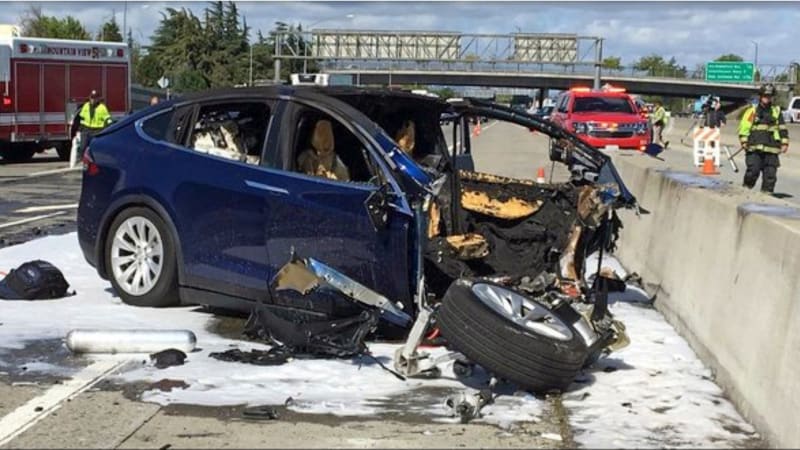Audi Repair Shop Doylestown
Call 267 279 9477 to schedule a appointment

DETROIT — An Apple engineer who died when his Tesla Model X hit a concrete barrier on a Silicon Valley freeway had complained before his death that the SUV’s Autopilot system would malfunction in the area where the crash happened.
The complaints were detailed in a trove of documents released Tuesday by the U.S. National Transportation Safety Board, which is investigating the March, 2018 crash that killed engineer Walter Huang.
The documents say Huang told his wife that Autopilot had previously veered his SUV toward the same barrier on U.S. 101 near Mountain View, California where he later crashed. Huang died at a hospital from his injuries.
“Walter said the car would veer toward the barrier in the mornings when he went to work,” the Huang family’s attorney wrote in a response to NTSB questions.
Huang also described Autopilot’s malfunctioning to his brother, the attorney wrote, in addition to talking with a friend who owns a Model X. Huang, a software engineer, discussed with the friend how a patch to the Autopilot software affected its performance and made the Model X veer, the lawyer’s response said.
Sometime prior to the crash, Huang took his Tesla to a service center to fix a “navigation error,” the attorney’s response said. But Tesla could not duplicate the problem and it was not repaired.
The Huang family is suing Tesla and California’s Department of Transportation for allegedly failing to maintain the highway.
Autopilot is a partially automated system designed to keep a vehicle in its lane and keep a safe distance from vehicles in front of it. It also can change lanes with driver approval. Tesla says Autopilot is intended for driver assistance and that drivers must be ready to intervene at all times.
The full NTSB board is scheduled to hold a hearing on the crash on Feb. 25. At that time, it will determine a cause and make safety recommendations.
NTSB staff members have already recommended that California transportation officials move faster to repair highway safety barriers damaged by vehicles.
A report from the agency says California officials failed to fix the barrier that was damaged in a crash 11 days before Huang was killed. In that incident, a 2010 Toyota Prius traveling in excess of 75 mph (120 kmh) crashed against the attenuator, a cushion that protects vehicles from hitting the end of concrete lane dividers. The 31-year-old driver survived the crash and was treated for relatively minor injuries, the NTSB said.
The California Highway Patrol responded to the March 12 crash but did not notify the California Department of Transportation of the damage as it is required to, the NTSB said.
Huang’s 2017 Tesla Model X was traveling at 71 mph (114 kph) when it crashed against the same attenuator, which the NTSB determined had been damaged and repaired more frequently than any other left-exit in Caltrans’ District 4, which includes all of the San Francisco Bay Area, a region of 7 million people.
In the three years before the Tesla crash, the device was struck at least five times, including one crash that resulted in fatalities. A car struck it again on May 20, 2018, about two months after the Tesla crash, the NTSB said.
California Department of Transportation spokesman Matt Rocco said the department is reviewing the NTSB report to determine its next steps but declined to answer questions.
“Safety remains Caltrans top priority,” he said.
Also on Tuesday, the NTSB released documents from another fatal Tesla crash, this one on March 1, 2019 in Delray Beach, Florida.
In that incident, driver Jeremy Banner turned on the Autopilot function of his Model 3 sedan 10 seconds before the crash, then took his hands off the steering wheel, NTSB documents said. The car then drove underneath a tractor-trailer that was crossing in front of it, sheering off the car’s roof and killing Banner. It was eerily similar to another Florida crash in 2016 in which a Tesla on Autopilot went beneath a semi trailer.
The NTSB said in a preliminary report that it still hasn’t determined the cause of the crash. According to the report, traffic was light on the four-lane highway and dawn was breaking when Banner, 50, set his speed at 69 mph (111 kph) and activated the autopilot as he headed to work. The speed limit was 55 mph (88 kph). Seconds later, a tractor-trailer driven by Richard Wood, 45, pulled from a driveway and began to cross to the other side of the highway.
Wood said he saw two sets of car headlights coming toward him, but he thought he had time to make it across. “It was dark and it looked like the cars was back further than they was,” Wood told NTSB investigators four days after the crash.
A photo taken by the NTSB from Tesla’s front-end video camera showed Wood’s trailer fully blocking the road 1.5 seconds before the crash. Data from the Tesla’s computer shows that Banner hit his brakes less than a second before the crash, but the car went under the trailer. Wood says he saw a second car but that one didn’t hit the trailer.
Palm Beach County firefighters who arrived minutes later found the Tesla about a quarter-mile (400 meters) down the highway with its engine running. The car had automatically shifted to neutral and turned on its emergency flashers when its computer detected the crash. They said that they had never dealt with a Tesla’s ignition before and didn’t know how to turn it off – that requires using a keycard. The department has since given its firefighters additional training.
Rodriguez reported from San Francisco. Terry Spencer contributed from Orlando, Florida.
Related Video:
from Autoblog https://ift.tt/2vmSeJW